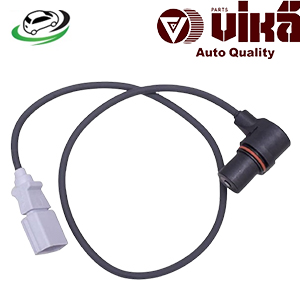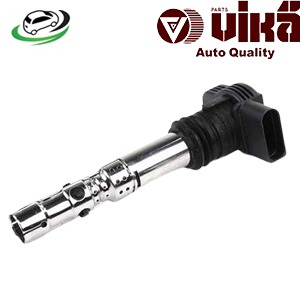-7%
Get AUDI B5 A4/ C5 A6/ C5 Allroad/ TT MKI / VW 337/20AE/ Golf IV/ Jetta IV/ Jetta IV GLI/ Passat B5 Ignition Coil 06A905115D
An ignition coil is a crucial component in a vehicle’s ignition system that converts the vehicle’s low battery voltage into the high voltage needed to ignite the air-fuel mixture in the engine’s cylinders. Without a properly functioning ignition coil, the engine would not run efficiently, if at all. This detailed explanation covers the purpose, types, operation, benefits, common issues, and maintenance of ignition coils.
What is an Ignition Coil?
An ignition coil is an induction coil that amplifies the voltage from a car’s battery (usually 12 volts) to the thousands of volts needed to create a spark across the spark plug gap, igniting the air-fuel mixture in the combustion chamber. In modern vehicles, ignition coils are either integrated into a single coil or multiple coils that work for individual or pairs of cylinders.
The ignition coil is part of a system that includes the battery, spark plugs, ignition switch, and other components. Together, they work to ensure that the vehicle’s engine starts and runs smoothly.
How Does an Ignition Coil Work?
The working principle of an ignition coil is based on electromagnetic induction. An ignition coil contains two sets of wire windings: the primary winding and the secondary winding.
- Primary Winding
The primary winding consists of a few hundred turns of thick wire and is connected to the vehicle’s battery. When current flows through this winding, it creates a magnetic field. - Secondary Winding
The secondary winding has thousands of turns of fine wire wrapped around the primary winding. When the current in the primary winding is suddenly interrupted by the ignition system (through the opening of breaker points or by the control module in modern vehicles), the collapsing magnetic field induces a high voltage in the secondary winding. - Voltage Amplification
The difference in the number of turns between the primary and secondary windings (turns ratio) causes the ignition coil to transform the 12 volts from the battery into a much higher voltage, typically ranging from 20,000 to 50,000 volts or more. - Discharge to Spark Plug
The high voltage generated by the ignition coil is then sent to the spark plug, where it jumps across the spark gap, creating a spark that ignites the air-fuel mixture in the combustion chamber.
Types of Ignition Coils
- Conventional Ignition Coils
In older vehicles with distributor-based ignition systems, a single ignition coil provides the high-voltage spark for all the cylinders. The distributor then directs this high voltage to the appropriate spark plug at the right time. This system is reliable but more mechanically complex than modern systems. - Coil Pack
A coil pack contains multiple ignition coils in one unit, often used in distributor-less ignition systems. Each coil in the pack is responsible for providing voltage to one or more spark plugs. Coil packs reduce the need for a distributor and are more efficient in terms of timing and spark distribution. - Coil-on-Plug (COP)
Coil-on-Plug ignition systems are one of the most modern types of ignition coils. In this setup, each cylinder has its own ignition coil mounted directly on top of the spark plug. This design eliminates the need for spark plug wires and offers more precise ignition timing, improving fuel efficiency and engine performance. - Coil-Near-Plug (CNP)
Similar to Coil-on-Plug systems, Coil-Near-Plug setups have individual ignition coils for each cylinder but are not mounted directly on the spark plug. Instead, they are placed near the plug and connected via short ignition wires. This design still provides more precise spark control compared to older systems.
Functions of an Ignition Coil
- Voltage Amplification
The ignition coil’s primary function is to step up the low voltage from the battery to a high voltage capable of igniting the air-fuel mixture inside the combustion chamber. - Reliable Spark Delivery
Whether in a conventional system or modern Coil-on-Plug design, the ignition coil ensures that a reliable and timed spark is delivered to the spark plugs, allowing for efficient combustion and engine operation. - Engine Start and Operation
Without a working ignition coil, the engine would not start. The coil provides the initial spark that ignites the fuel-air mixture during cranking and continues to provide the spark necessary for the engine to run smoothly.
Benefits of a Well-Functioning Ignition Coil
- Improved Engine Performance
A healthy ignition coil ensures that the engine receives consistent, strong sparks, leading to smooth acceleration, stable idling, and responsive throttle control. A faulty coil can cause misfires, reduced power, and poor overall engine performance. - Fuel Efficiency
With proper spark timing and voltage, the combustion process becomes more efficient, resulting in better fuel economy. If the ignition coil is malfunctioning, incomplete combustion may occur, leading to wasted fuel and lower mileage. - Reduced Emissions
Proper combustion is key to reducing harmful emissions. When the ignition coil works correctly, the engine burns fuel more completely, lowering the output of unburned hydrocarbons, carbon monoxide, and nitrogen oxides. - Longer Engine Life
Regular and reliable sparks help maintain optimal combustion, reducing the strain on engine components. This results in less wear and tear on parts like pistons, valves, and the catalytic converter, prolonging the engine’s lifespan.
Common Symptoms of a Faulty Ignition Coil
- Engine Misfires
One of the most common signs of a failing ignition coil is engine misfires. A weak or intermittent spark can cause the air-fuel mixture to fail to ignite, leading to incomplete combustion and a noticeable misfire. Misfires can be felt as a hesitation or jerking sensation while driving, especially during acceleration. - Poor Fuel Economy
A malfunctioning ignition coil can cause the engine to burn fuel inefficiently, resulting in increased fuel consumption. If you notice that you need to fill up your tank more often than usual, a failing ignition coil could be the culprit. - Check Engine Light
In modern vehicles, a faulty ignition coil may trigger the Check Engine Light. This occurs because the engine control unit (ECU) detects misfires or other issues related to the ignition system. A diagnostic scan can pinpoint the specific cylinder or ignition coil causing the problem. - Hard Starting
If the ignition coil is unable to provide a strong enough spark during engine cranking, you may experience difficulty starting the vehicle, especially in cold weather. This is because the air-fuel mixture is harder to ignite when the engine is cold. - Rough Idling
A faulty ignition coil can cause the engine to idle roughly or vibrate excessively when the vehicle is stopped. This occurs because one or more cylinders are not firing properly, leading to an imbalance in engine operation. - Loss of Power
A weak ignition coil can lead to a noticeable loss of power, especially under heavy load or during acceleration. If the engine feels sluggish or unresponsive, the ignition system may not be providing the necessary spark for efficient combustion.
Ignition Coil Maintenance and Replacement Tips
- Regular Inspection
Ignition coils should be inspected regularly, especially if the vehicle shows signs of misfiring or poor performance. Look for visible signs of damage, such as cracks in the coil housing or burn marks around the connectors. - Check for Corrosion
The terminals and connectors of the ignition coil should be free from corrosion. Moisture and corrosion can cause poor electrical connections, leading to coil failure. If you notice any rust or corrosion, clean the terminals and apply dielectric grease to prevent further damage. - Replace Spark Plugs and Coils Together
If you are replacing the spark plugs, it’s often a good idea to replace the ignition coils as well, especially if the vehicle has high mileage. Worn-out spark plugs can cause the ignition coil to work harder, leading to premature coil failure. Replacing both components at the same time ensures optimal performance. - Use OEM or High-Quality Aftermarket Coils
When replacing an ignition coil, it’s important to use either original equipment manufacturer (OEM) parts or high-quality aftermarket parts. Low-quality coils may not provide the same level of performance and could fail prematurely. - Monitor Engine Codes
If the Check Engine Light comes on, use an OBD-II scanner to read the trouble codes. Misfire codes (P0300-P0308) can help identify which cylinder is having ignition problems, allowing you to diagnose and replace the faulty ignition coil. - Replace Coil Boots
In Coil-on-Plug ignition systems, the rubber boots that connect the ignition coil to the spark plug can deteriorate over time. Cracked or worn boots can cause arcing, leading to misfires. When replacing the ignition coil, check the condition of the boots and replace them if necessary. - Maintain Battery Health
Since the ignition coil relies on the vehicle’s battery for power, maintaining a healthy battery is essential for proper ignition coil operation. A weak or dying battery can cause insufficient voltage to the ignition system, leading to coil failure.
Conclusion
The ignition coil plays an essential role in ensuring the smooth operation of a vehicle’s engine by converting low voltage from the battery into the high voltage needed to create a spark at the spark plugs. Proper ignition coil function is critical for engine performance, fuel efficiency, and emission control. Regular maintenance, timely replacement, and proper inspection of the ignition coil can prevent misfires, improve performance, and extend the life of your engine.
Follow us on Facebook for more parts.




Reviews
Clear filtersThere are no reviews yet.